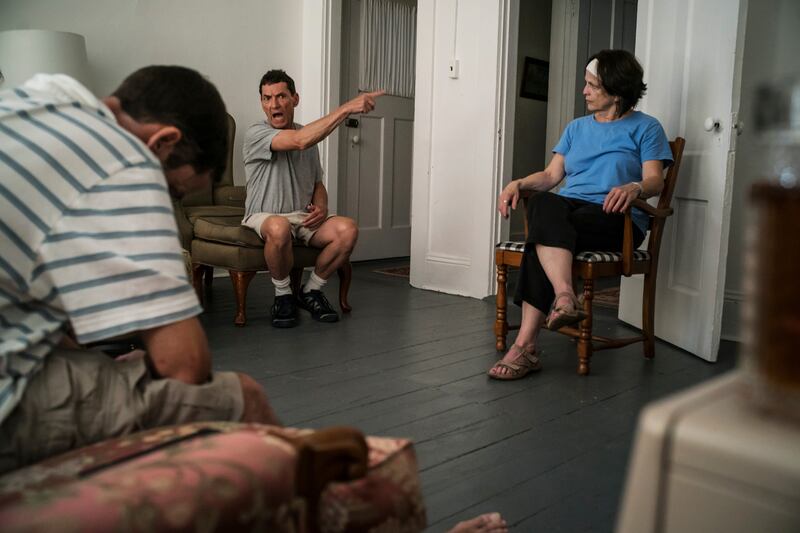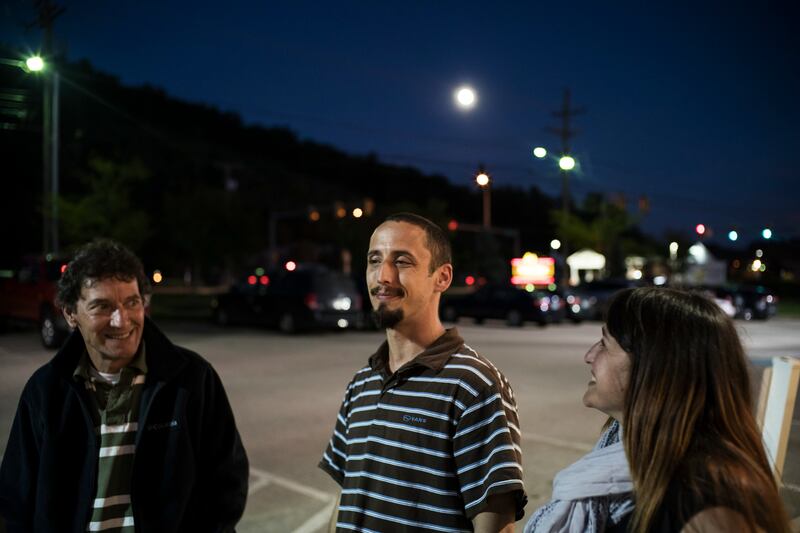The first time Patrick Griffin overdosed one afternoon in May, he was still breathing when his father and sister found him on the floor around 1.30pm.
When he came to, he was in a foul mood and began arguing with his father, who was fed up with his son’s heroin and fentanyl habit.
Patrick, (34), feeling morose and nauseous, lashed out. He sliced a love seat with a knife, smashed a glass bowl, kicked and broke a side table and threatened to kill himself. Shortly after 3, he darted into the bathroom, where he shot up and overdosed again. He fell limp, turned blue and lost consciousness. His family called 911. Emergency medical workers revived him with Narcan, the antidote that reverses opioid overdoses.
Throughout the afternoon his parents, who are divorced, tried to persuade Patrick to go into treatment. His father told him he could not live with him anymore. Around 4, Patrick slipped away and shot up a third time. He overdosed again, and emergency workers came back and revived him again. They took him to a hospital, but Patrick checked himself out.
Back at his mother's house in Pembroke, New Hampshire and anxious to stave off withdrawal, he shot up again around 7.30pm, overdosing a fourth time in just six hours. His mother feared he was dead. Rescue workers returned and administered three doses of Narcan to bring him back. At that point, an ambulance took him to the hospital under a police escort and his parents – terrified, angry and wrung out – had him involuntarily admitted.
The torrent of people who have died in the opioid crisis has horrified the nation, with overdose now the leading cause of death for Americans younger than 50.
But most drug users do not die.
Far more, like Patrick, are snared for years in a consuming, grinding, unending cycle of addiction.
In the 20 years that Patrick has been using drugs, he has lost track of how many times he has overdosed. He guesses 30, a number experts say would not be surprising for someone taking drugs off and on for that long.
Patrick and his family allowed the New York Times to follow them for much of the past year because they said they wanted people to understand the realities of living with drug addiction. Over the months, their lives played out in an almost constant state of emergency or dread, their days dictated by whether Patrick would shoot up or not.

"We are your neighbors," his mother, Sandy Griffin, said of the many families living with addiction, "and this is the BS going on in the house."
In Patrick’s home state of New Hampshire, which leads the country in deaths per capita from fentanyl, almost 500 people died of overdoses in 2016. The government estimates that 10 percent of New Hampshire residents – about 130,000 people – are addicted to drugs or alcohol. Some people do recover, usually after multiple relapses.
For much of his adult life, Patrick, who once dreamed of writing graphic novels, has had no job and no prospects. He has a lengthy record of arrests. He got money to buy drugs by selling them at a profit.
Dennis, (66), a retired iron worker, spends his days on the phone, trying to assist his addicted son with lawyers, counselors, insurance companies, even politicians.
Patrick’s younger sister, Betsy, (29), who used to shoot heroin with him, is in recovery and has a job, but Patrick’s influence is a constant threat.
Sandy, (59), a waitress, knows that her children could at any time pick up a needle. If they did, would it be for the last time?
“He needs to learn to live with the pain of being alive,” Sandy said.
AN INTERVENTION
One day in July, Patrick’s family staged a spur-of-the-moment intervention in his mother’s living room in Pembroke, a town in central New Hampshire.
Dennis told Patrick he could no longer live with him and urged him to seek help.
Patrick shot down every suggestion.

Dennis told Patrick, who had overdosed once again the night before, that he should turn himself in to the “safe station” program at the fire department, which helps people with addiction find treatment.
Patrick scoffed.
As a young teenager, Patrick had been bullied, and later he was diagnosed with attention deficit hyperactivity disorder, his parents said. He said he started self-medicating at age 14 with beer and marijuana, then moved on to cocaine and crystal meth. The meth made him vomit, so he turned to prescription painkillers that his friends stole from their parents. When the government tightened the supply of painkillers, Patrick sought out heroin and fentanyl.
“I thought, ‘Nothing is going to kill me,’” he said.
Years later, he was diagnosed with major depression and borderline anti-social personality disorder, his family said, and more recently, post-traumatic stress disorder, illnesses that often go hand-in-hand with substance misuse. He has been on and off antidepressants.
Several hours into the family intervention, Patrick stepped out of the room.
Ten minutes later, he returned. His eyes drooped. He twitched.
As his parents despaired over his future, he had been getting high.
‘NEEDLES ALL OVER’
Patrick was high again a day later when he was arrested at a Burger King with a bag of Xanax bulging from one of his socks. He was charged with possession with intent to distribute, then blacked out.
He awoke in a small, concrete cell, charged with three felonies and two misdemeanors.
In jail, he was kept from all drugs, including Suboxone, an opioid substitute that eases withdrawal symptoms and that Patrick had been prescribed by a doctor years earlier as part of an effort to transition him into treatment. New Hampshire is among several states that have banned Suboxone from prisons because inmates often sell it to each other, sometimes leading to overdoses.
Patrick went into an intense withdrawal, with extreme vomiting and diarrhea, in a cramped 6ft-by-8ft cell.
He spent seven weeks in jail, then 28 days in an inpatient treatment program as his legal case made its way through the courts.

By early October, the program was done, he was temporarily released on his own recognizance, and he had been drug-free for almost three months. And yet his family churned with anxiety.
“He’s going to come back and do the exact same thing, and I don’t know how to stop it,” Dennis said before Patrick was released and moved back in with him. “I find needles all over the house.”
Still, this time, Patrick seemed different.
Patrick and his father joined a gym and began working out together. Patrick muscled up and put on 30 pounds.
But without drugs, Patrick said, he felt lost. He was not in treatment, had no mental health counselor and no job. If he wanted treatment to help him keep his resolve, he could not afford it. He had no insurance — incarceration automatically cost him his Medicaid benefits.
DIVERGING PATHS
Patrick’s sister Betsy has also been in and out of rehab and jail. But she is in recovery now and her life looks far different. She has a job working at an animal rescue shelter, her sights set on becoming a veterinary technician.

All of it raises a question: Why is one person from the same family who has the same attraction to drugs able to stop, but another cannot seem to?
Sandy said that Betsy, who completed a highly structured treatment program and underwent cognitive behavioral therapy, seemed more motivated than Patrick to quit.
Patrick said Betsy had succeeded where he had not because she had found passion in her work.
“She loves those dogs,” Patrick said.
He said that during periods when he has been clean, he tends to take on too much, as he did last year when he signed up for multiple coding courses at community college. He said the heavy caseload left him frustrated, with failing grades. That preceded the relapse in May.
As a late fall day turned to dusk, Patrick said he had not used drugs since he went to jail in July. But he also said he had no idea how to break free from his cravings.
“I feel like I’ve got nothing to offer,” he said. “I’m depressed all the time, and I’m isolating myself. I don’t really know what sober people do.”
SEEKING SOLID GROUND
Over the next two months, things would look up for Patrick. He got the job at a packaging plant. His Medicaid benefits were restored. He was on antidepressants and was back in counseling.
And at a court hearing this month, his legal case was more or less resolved: In a deal worked out with the prosecution, he planned to plead guilty to two misdemeanors, with the other charges dropped. Any jail sentence would be suspended as long as his good behavior continued and he stayed in counseling.
But the threat of relapse is constant.
When Patrick recently texted Sandy, saying, “I love you,” her first thought was that he was about to kill himself.
She frantically called him back. Patrick told her he was fine, he had just been thinking about her.
For a moment, Sandy caught her breath.


















